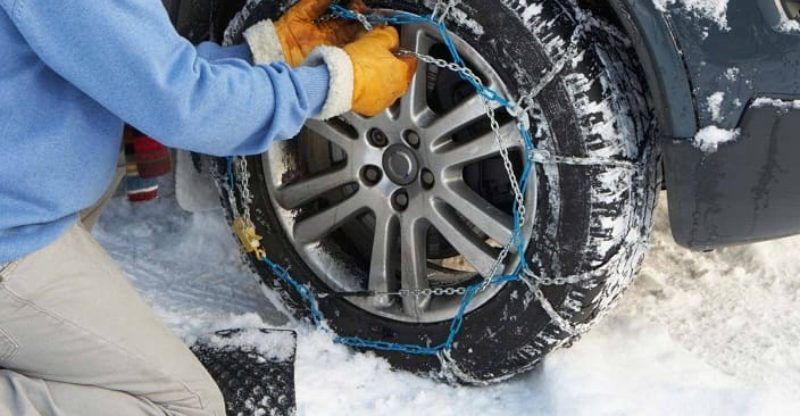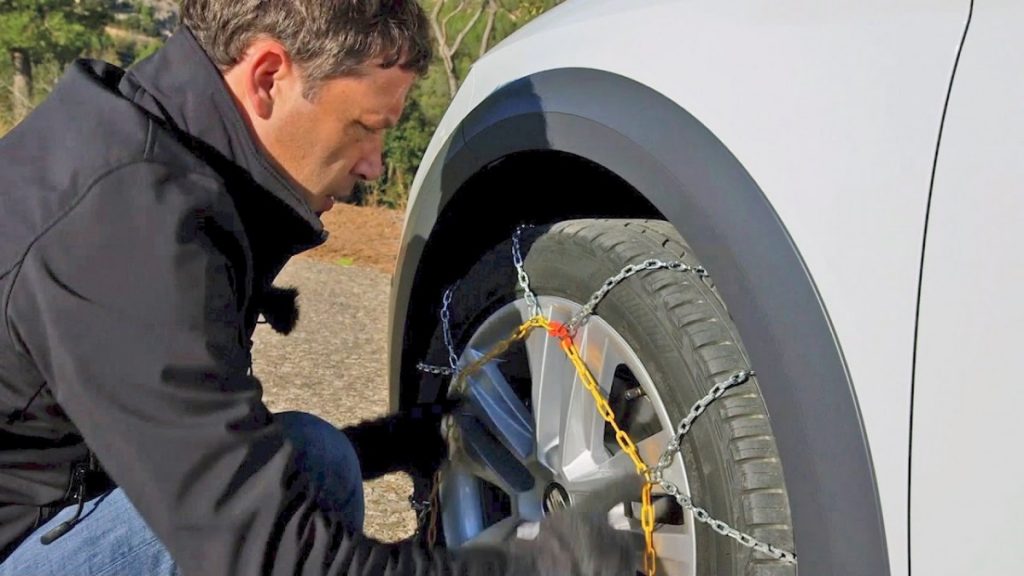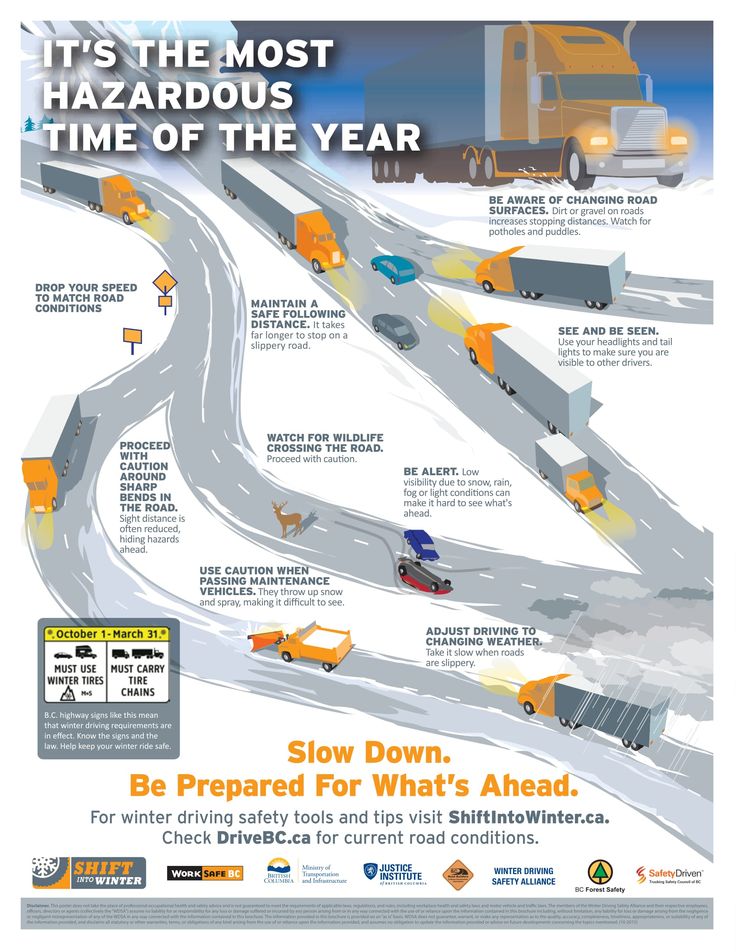Can you drive snow and winter tires year round? It’s an idea that occurs to many drivers who experience winter weather: If I have to mount snow tires every year, why don’t I just keep them on my vehicle all the time?
Unfortunately, using snow tires year round isn’t recommended. In the long run, it will cost more money than changing them out and could compromise your vehicle’s performance on the road. That’s why tire makers offer different types of tires for different seasons – the best option for you is determined by many factors including climate, driving style, and performance needs.
Here are some specific reasons why year-round use of winter tires is not advised. And if it’s the hassle of tire mounting, unmounting, and remounting that you’re tired of, we’ve included an idea for simplifying that process, too.
All winter tires, whether studless or studded, are made to maintain better traction in extreme cold, and on icy, snowy, or slushy roads. The rubber is able to remain softer, which makes it more flexible, allowing the tire to conform to the road better in extremely cold conditions. This feature, along with deeper tread depths and specialized tread designs, are what make snow/winter tires ideal for inclement winter weather and extreme cold driving conditions.
We use this analogy - tennis shoes. Yes, you can wear tennis shoes on the beach or in the snow, but wouldn't it be better to have flip flops on the beach and boots for the snow? Winter tires are like snow boots for your car.
Winter tires are specially designed for cold temperatures and winter precipitation. Once it gets warm, you won't need deep tread depths to handle snow or biting edges for traction on ice. Here are some specific reasons why using winter tires year round is not recommended.
Faster wear on warm, dry pavement - the tread rubber of winter tires is considerably more flexible than that of all season and summer tires. That same pliable tread rubber that adds traction in winter will wear down quickly in warm temperatures. Summer and all-season tires are built to withstand warm temperatures, providing long wear life.
That same pliable tread rubber that adds traction in winter will wear down quickly in warm temperatures. Summer and all-season tires are built to withstand warm temperatures, providing long wear life.
Decreased performance - In warm weather, winter tires won't provide the same handling capabilities as summer or all-season tires. Imagine if you needed to make a quick maneuver and your tires were soft and squishy. You won't get the crisp response from a winter tire in warm weather. Winter tires need that flexibilitity to handle ice and snow, but it's not as useful in warm weather.
The specialized compounds and tread designs of winter tires are not designed for optimal warm climate performance and wear. Generally speaking, the softer tread of a winter tire will wear out faster in warmer temperatures. If you keep winter tires on your vehicle after winter has come and gone, you will have to replace them sooner than had you removed them for springtime.
That’s why using snow tires year round is more expensive than mounting them seasonally. The sooner they wear out, the sooner you have to replace them.
The sooner they wear out, the sooner you have to replace them.
Driving on snow tires year-round could compromise optimal tread wear and ultimately be more expensive than just changing tires out for the season.
If you were considering year-round use of winter tires because you were tired of having to change them, here’s an idea that could save you time and money. Purchase wheels with the same diameter and bolt pattern as your current wheels. Mount your snow tires on those and store them in the garage until winter arrives.
Instead of having to change out your tires each season, just have a technician change the wheels. It’s a quick, relatively inexpensive alternative to mounting and unmounting snow tires every season.
Even with the best snow tires on the market, changing temperatures affect their ability to grip the road's surface. Listen to the pros, and know what to expect when the thermometer drops.
Listen to the pros, and know what to expect when the thermometer drops.
Learn More
Even with the best snow tires on the market, changing temperatures affect their ability to grip the road’s surface. Listen to the pros, and know what to expect when the thermometer drops.
LEARN MORE
Underneath my Youtube videos about icy roads, you'll see dozens of commenters talking about winter tires. So what's the story? Are winter tires worth it? Are they the silver-bullet solution for preventing accidents during winter weather? To find out, in 2016, I purchased a set of winter tires (I paid for them personally) and used them during two seasons of my normal news coverage of icy roads across the country. I put them to the test on all types of road icing, from snow to sleet to freezing rain. In this article, we'll cover the results of these tests and separate the myths from the facts about winter tires. Winter tires VS all-seasonsThere are two main differences between winter and all-season tires. Winter tires use a softer rubber compound that is better at providing grip on snowy surfaces. The rubber in all-season tires, by contrast, tends to harden during cold weather and as a result, slide much more easily. Contrary to popular belief overseas, most people in the USA use all-season tires instead of summer tires. FACT: Winter tires perform very well on snowpacked roadsSnowy conditions are where winter tires shine. On slight inclines where all-seasons would spin fruitlessly, winter tires grab and keep the vehicle moving with few issues. I was able to start from a full stop on this hill near Pittsburgh, with very little wheel spin. The car is noticeably more stable when driving on snow, with much less wheel spin or antilock brake action. As I'll cover later though, winter tires will still slide if you are going too fast for the conditions or encounter a steep enough hill. Winter tires tackled this Pittsburgh hill with ease. Combined with the essential practice of slowing to a safe speed for the conditions, winter tires will dramatically increase your overall safety and stability on snow-covered roads. MYTH: Winter tires are just as effective on ice.I can assure you that winter tires will slide on ice with little provocation! I experienced just as much antilock brake action and general instability on the more slick types of road icing (such as freezing rain and untreated re-frozen snowmelt) as I do with all-seasons. Traveling too fast on the more slick types of road icing will get you into just as much trouble as you would with all-season tires. Winter tires sliding on freezing rain icing
You've probably seen the "ice rink" tests where vehicle stopping distances are tested with winter vs all-season tires. On ice, the only effective solution for a meaningful increase in stability are studded tires. Stud use is problematic for most people in the US, as the incidence of icy roads is too infrequent to keep them installed for lengths of time. Furthermore, studs are not legal in some states because they are damaging to roads [1]. Studs also reduce dry-weather handling, as they cause less of the tire tread to be in contact with the road surface. MYTH: You can drive at normal speeds on icy roads with winter tires.I'll reiterate this: winter tires can and do still slide on slick roads. They may have a slightly higher margin of safety than all-seasons, but they still have a limit! If you exceed that margin, you will slide and lose control in the same manner as you would with all-season tires. Like other vehicle safety features such as ESC, ABS and 4WD/AWD, winter tires have their limits. When the vehicle is driven beyond those limits due to overconfidence in the equipment, the end result is the same: an unstable vehicle state on the brink of a slide and loss of control. An overconfident driver with a safety-feature-rich vehicle will be at a greater risk of injury than the average driver as their accidents will tend to happen at higher speeds. FACT: Running winter tires involves additional expensesIn terms of the tires themselves, a set of good winters costs about the same as all-seasons. For my small Toyota Yaris, I paid around $450 for my set of a name-brand version. The true cost of using winter tires comes with having to switch them out each season. If you use your stock wheels only, tire shops will charge for mounting and balancing each time you swap the two sets. This can be 50 to 100 dollars or more each time, and you'll be paying that twice a year. Some tire shops even have a policy to not mount used tires.
To avoid the recurring mount & balance costs, it can be cost effective to purchase a second set of wheels for the winters to be permanently mounted - especially if you use them for more than two seasons. This is the recommended course of action, though it can be expensive: depending on the vehicle, this could be $500 to $1000 or more in addition to the cost of the tires. MYTH: Winter tires perform better than all-seasons in cold weatherThis is a common selling point you'll hear, but I saw no noticeable difference in handling in dry, cold weather between my winter and all-season tires. You don't buy winter tires for dry, cold weather - you get them for snow. If you never or rarely see snow-covered roads, there is little or no reason to use winter tires. FACT: Winter tires handle very poorly in warm or rainy weather.Since winter tires are made of softer rubber compounds, they are noticeably "squishy" during warm weather. More importantly, winter tires can be dangerous on wet roads at highway speeds. Nearly all brands have very poor wet-road braking performance. This instability is very noticable and is downright scary! I experienced an incident during hard braking on an interstate at 60mph with only marginally-wet pavement (with temperatures near 50°F): I began to fishtail and my electronic stability control (ESC) system activated to keep the car straight. I don't feel safe going greater than 50mph on wet roads when I have my winter tires mounted.
This means if you see as much rain during the winter months as you do snow and ice (as we do here in St. FACT: For most people in the US, winter tires are impracticalYes, it's true: winter tires are amazing on snow-covered roads. So why doesn't everyone use them? The main reason is that for most places in the United States, icy roads only happen a handful of times a year. Most of the US is not like Finland, Sweden or Russia where roads are snowpacked for much of the winter. Where I live in St. Louis, we see ice or snow on the road only 5 to 10 times each year, and that for only a few hours at a time. In much of the Southern US, snow or ice on the road only happens every 1 to 3 years. The map below shows the average number of days that winter weather occurs, by county, in the United States: Source: FEMA
As you can see, there aren't many places that see snow and ice on the road more than 10 times each winter. Furthermore, in regions with mild winters, the poor handling of winter tires outside of the few icy road events means that a vehicle's overall safety could actually decrease with winters installed.
All of this means that for most people in the US, it doesn't make a lot of sense to go through the extra expense of winter tires when there are so few times that they'll be beneficial. You can greatly reduce your chances of an accident during the occasional icy road event by simply slowing down to a safe speed, even with all-season tires. Furthermore, winter tires don't make a vehicle immune to accidents on ice and snow. Winter tires will still slide, especially on the more slick types of road icing. On freezing rain icing for example, I did not see a noticeable difference in braking performance. ConclusionsShould you buy winter tires? The answer primarily depends on where you live. If you're living in a more snow-prone location, particularly with hilly terrain, winter tires are a no-brainer. Outside of that rare demographic, you should be able to get by just fine without them as long as you reduce your speed when snow and ice are a threat. Even the tire manufacturers agree - they don't stock winter tires in most places, nor do they attempt to market them outside of the snowiest regions. Driving at a safe speed for the conditions for those few days out of the year that the roads are icy (or better yet, staying home or postponing your travel) is an adequate strategy for dealing with the occasional winter weather event. If you are driving too fast for the conditions, winter tires will only slightly decrease your chances of losing control. Even the tire manufacturers agree - they don't stock winter tires in most places, nor do they attempt to market them outside of the snowiest regions. Driving at a safe speed for the conditions for those few days out of the year that the roads are icy (or better yet, staying home or postponing your travel) is an adequate strategy for dealing with the occasional winter weather event. If you are driving too fast for the conditions, winter tires will only slightly decrease your chances of losing control.
Sources
Educational Winter Driving Videos - Watch for Free:
|
Vladimir Gavrilov
Estimated reading time: 5 minutes
29267
Category: Driving technique
The spring sun melts the snow on intercity roads. Many motorists in a good mood accelerate their cars to high speeds. However, they forget that winter tires lose to summer tires in terms of speed.
When developing different models of cars, engineers select tires for them so that they meet the declared characteristics of the car in terms of stability and handling. Almost always, these are summer tires that work well up to a temperature of +7 degrees and lose their properties in the cold. Winter tires always lose to summer tires in all respects and cannot provide passport dynamic characteristics of the car. So that drivers do not forget about this, in Germany winter wheels are accompanied by stickers indicating the permissible permitted speed. These labels must be glued on the central panel so as not to inadvertently go to prohibitive travel modes.
In Russia, in winter and summer, the maximum speed on the country's highways is limited to 90 km/h or, on toll motorways, to 110 km/h. In rare cases, there are paid sections with a permitted speed of 130 km / h. Therefore, reminders of the high-speed mode, as it were, are not needed. However, few drivers remain true to the rules. Therefore, before accelerating, it is necessary to carefully study the wheels.
“Every tire has a speed index. It is imprinted on the sidewalls in the form of a letter designation and is adjacent to the load index, says tire expert Alexey Zayakin . - Winter wheels have them smaller. The manufacturer guarantees that the characteristics of the tire will be maintained only within the limits of the speed set by him. If you exceed the threshold, then there is a great chance of an increase in unregulated loads and subsequent destruction of the tire.
The letters A, B, C, D, E, F, G, J are used on wheels for special equipment, but for passenger cars, tires with a speed index of over 120 km / h are made. This is much less than the engine can accelerate. For example, if a car has specific high-profile N tires and it accelerates to 200 km / h on dry pavement, then there is a great chance to end up in a roadside forest, since the tires simply will not hold the car when turning.
This is much less than the engine can accelerate. For example, if a car has specific high-profile N tires and it accelerates to 200 km / h on dry pavement, then there is a great chance to end up in a roadside forest, since the tires simply will not hold the car when turning.
A simple dependency needs to be remembered. The softer the wheel, the higher its speed characteristics, but the lower the service life. Therefore, high-speed wheels almost always wear out quickly.
As the speed increases, the load on the rubber increases and wear increases. “The car first accelerates, which often leads to slight slips on the pavement, and then it slows down just as intensively at high speed,” says Vyacheslav Subbotin, engineer and captain of the GAZ Raid Sport rally team, to . - Therefore, the durability of tires is affected not only by the maximum speed, but also by the intensity of acceleration and braking. Studded wheels are the most sensitive to them.
During sharp acceleration and deceleration, metal spikes scratch on the asphalt, take on a huge part of the loads and eventually fly out. This reduces the grip of the wheel on ice.
Therefore, in order for the tire to serve for a long time, you need to follow a few simple rules:
winter tires advice for motorists
Next article
 How are tires different?
How are tires different? Media news2
In modern car shops you can find such a large selection that buying a simple thing becomes a real problem for the driver. You need to compare all manufacturers, find a product that fits a particular brand of car, compare the cost at different points of sale, and so on.
You need to compare all manufacturers, find a product that fits a particular brand of car, compare the cost at different points of sale, and so on.
Often, behind these problems, we forget about the main criteria for choosing a product for a car. If we are talking about rubber, then the choice of manufacturer is far from being as important as the correct selection of sizes and indexes. It is the latter factor that will be discussed next.
The tire speed index parameter has been around for a long time. All manufacturers of rubber for automobiles mark their products in accordance with the requirements of the index tables.
There is a single speed designation table that is used for all modes of transport. Many people think that the designation of the speed index for summer and winter tires is different, but this is not so. A standardized table is used to define the index. The most common in our country are the following indices:

There are also indexes of the ZR group, which are designed for sports cars. In these indices, the maximum speed of a car can reach up to 350 kilometers per hour. The standard index group is called ECE R30.
As a rule, a higher speed tolerance applies for summer tires, so the lettering on summer and winter tires from the same manufacturer often differs. Manufacturers only reinsure themselves in this way, limiting the maximum permissible speed of the car in winter.
Any modern rubber has size designations, the manufacturer's name, as well as speed and maximum load indices on the side of the tire. For example, 165/70 R13 is a tire size designation. This is followed by the name of the company that produces rubber, and then the indices are indicated as follows: 88Q. The number is the maximum load index, and the letter is the speed index we need.
This parameter must be taken into account when buying tires, because the higher the speed index, the safer your car will be. Deciphering the markings in the auto rubber store will not give you any trouble.
Manufacturers strongly recommend adherence to the parameters indicated in the index. If the tires of your car have a speed index P, then driving at a speed greater than 150 kilometers per hour will be extremely dangerous.
Many accidents on the tracks are due to non-compliance with tire speed indexes. This is especially true for truck tires, because they have the smallest speed indexes.
When buying tires, pay special attention to the speed and load indexes. This will help you choose the right tires for your driving style.